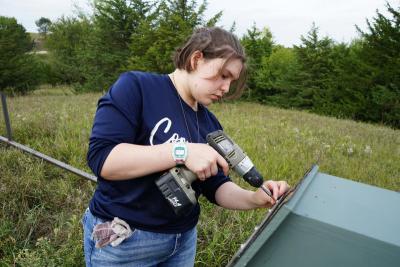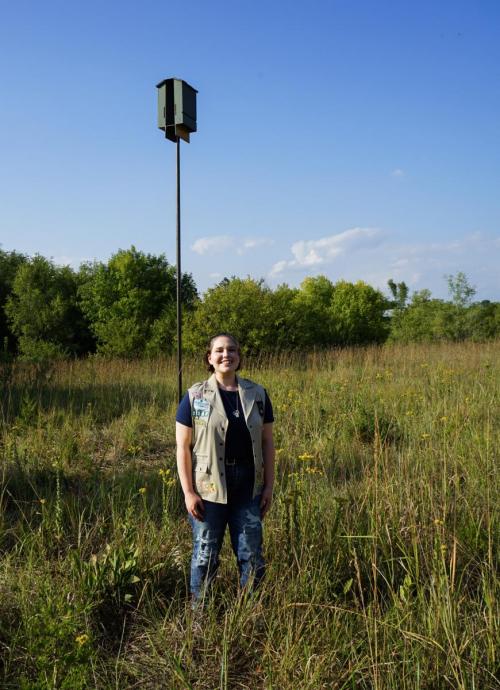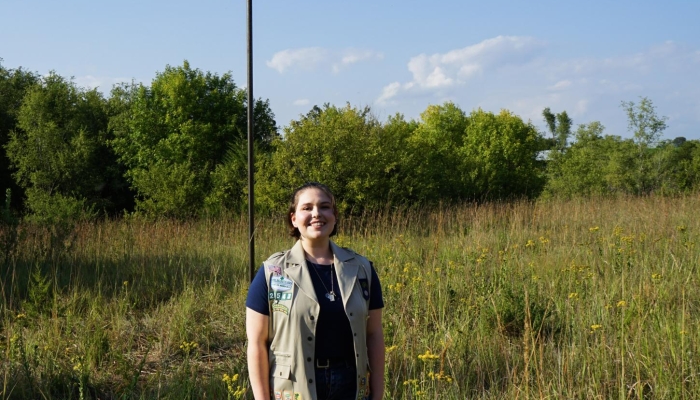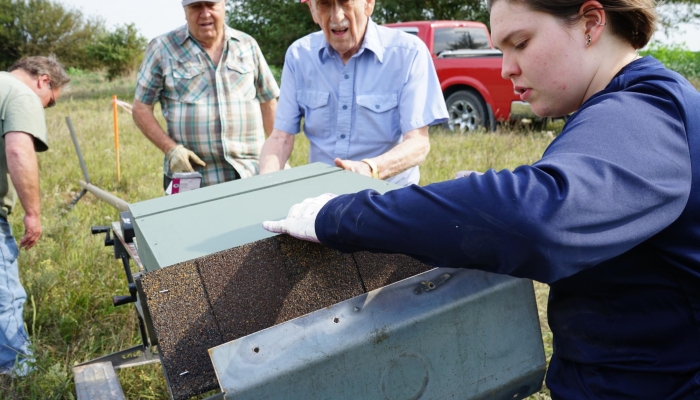Girl Scout’s Project Celebrates Ecology and Community
Bats get a bad rap in popular culture. With frequent appearances in vampire films and haunted house attractions, bats are usually viewed as sinister, creepy, or malevolent.
The truth is, bats are highly beneficial, providing valuable insect control and pollination services. They are an important part of a healthy ecosystem in Nebraska, and Girl Scout Elizabeth Marsh is here to stand up for the misunderstood species, especially as we enter ‘spooky season.’
For her final scouting project, Marsh constructed a bat sanctuary at two recreation areas managed by the Upper Big Blue Natural Resources District in York. The capstone project is to earn the Gold Award, the most prestigious award in Girl Scouts. Gold Award projects utilize skills acquired through years of scouting to help fix a problem in the scout’s community or make a lasting change in their world.
Why did Marsh settle on bats to accomplish this goal?
Living in a town with so many old buildings, Marsh, a York native, says she’s seen her share of bats in places where they shouldn’t be--in a classroom, in the church sanctuary, even in the post office. “It really upset me to know people were killing bats when they were in buildings, especially since they are a protected species in most states,” said Marsh. At summer camp, she had seen bat houses. “I thought they were pretty cool, like a weird looking bird house,” she said.
 Her goal with the sanctuary project is to put bats in the right place, out of homes and urban structures, and into a habitat where they will be safe and have plenty to eat. Reducing interactions between humans and bats is important to helping the bats thrive. “I thought, let’s try to get the bats out of our houses and buildings and see if these structures can reduce needless bat deaths,” she said. In the future, wildlife professionals removing bats from homes and businesses will be able to rehome bats to the sanctuary.
Her goal with the sanctuary project is to put bats in the right place, out of homes and urban structures, and into a habitat where they will be safe and have plenty to eat. Reducing interactions between humans and bats is important to helping the bats thrive. “I thought, let’s try to get the bats out of our houses and buildings and see if these structures can reduce needless bat deaths,” she said. In the future, wildlife professionals removing bats from homes and businesses will be able to rehome bats to the sanctuary.
Marsh began the research and fundraising portion of this project in 2018. Work was delayed by the pandemic, as building materials became too expensive or unavailable, and in-person fundraising events had to be postponed. Eventually, Marsh was able to bring the project to completion. The bat houses were installed at Bruce L. Anderson Recreation Area and Overland Trail Recreation Areas in early September.
The bat houses Marsh constructed are thin, rectangular boxes with an open bottom and a shingled, slanted roof. They are painted a muted green and are mounted on 20-foot poles. Inside the boxes are four chambers with grooved walls that the bats will climb, and vents to ensure proper air flow. Marsh estimated once she had all the materials assembled, it took about 30 hours to build the ten boxes. Each box could potentially house 100-150 bats, as in winter they huddle close together to hibernate.
In the wild, bats tend to live under loose bark, among foliage, or in hollow trees, caves, quarries, and cracks of rocky ledges. In urban areas, bats will roost in attics or behind shutters, in downspouts, under bridges, or in storm sewers. While bats are beneficial in many circumstances, they can prove to be a threat to human health if they’re in your home. They can also leave behind smelly mounds of guano and be a noise nuisance. If you have bats in your home, Marsh suggests calling an expert in wildlife removal, rather than attempting to relocate bats yourself. While less than one half of one percent of bats carry rabies, it is never advisable to handle wild animals due to risk of infection.
 Bats can enter a building though a gap as small as 3/8 inch, often around eaves, vents, and chimneys. Marsh says that installing a bat box on your property is a great way to keep bats from making a home inside your attic or chimney, as they would prefer to live away from humans and other animals if they have a good alternative at hand. “They will feel safer inside of a bat house and have an easier time getting in and out,” she said.
Bats can enter a building though a gap as small as 3/8 inch, often around eaves, vents, and chimneys. Marsh says that installing a bat box on your property is a great way to keep bats from making a home inside your attic or chimney, as they would prefer to live away from humans and other animals if they have a good alternative at hand. “They will feel safer inside of a bat house and have an easier time getting in and out,” she said.
Initially Marsh thought of installing the bat boxes along Beaver Creek Trail in York but feared that having them in a high traffic area close to downtown might lead to negative interactions with humans. “I just didn’t want anyone to mess with them,” she said. She connected with the Upper Big Blue Natural Resources District in 2021 to see about placing them at the two recreation areas in York and the project was met with enthusiasm. The recreation areas are ideal, said Marsh. “There’s lots of space where they’ll be far from people, water nearby, and fields full of bugs for them to eat.”
Marsh doesn’t expect to see bats moving into the houses right away. The houses must be marked with guano to attract area bats to move in. She thinks they likely won’t be inhabited until spring, when bats are emerging from hibernation and preparing for the next generation to be born.
The project was as much about community as ecology for Marsh. “I wouldn’t have been able to get this done if it hadn’t been for my family and my community. I didn’t have the skills or the equipment to do this on my own,” she said. She drew on resources in her network to raise the funds and to build and install the structures. A relative of Marsh's owns Smith Welding and donated time for the design and construction of the mounting poles. Whether it was a senior mentor showing her how to use a table saw, friends assisting with the sanding and painting, or her church hosting a biscuits-and-gravy feed with a freewill donation for the project, it was a group effort to get it done. “It’s the sense of community that I’ve developed that makes this worth it,” she said.
Marsh is a freshman at Concordia University, where she is studying environmental science. She is planning for a career as a conservation biologist and hopes to work in the non-profit sector. In addition to providing bats with a safe place to live and reducing the amount of mosquitos at local recreation areas, Marsh hopes that this project will remind people that bats have many good qualities.
“I wish people weren’t so scared of them,” she said. “Most of the time, bats want nothing to do with you. They’re great pollinators. They keep insect populations down. They’re just all around wonderful for the environment. Maybe if people aren’t so scared of them, they won’t be as likely to kill them when they come across them.”
The truth is, bats are highly beneficial, providing valuable insect control and pollination services. They are an important part of a healthy ecosystem in Nebraska, and Girl Scout Elizabeth Marsh is here to stand up for the misunderstood species, especially as we enter ‘spooky season.’
For her final scouting project, Marsh constructed a bat sanctuary at two recreation areas managed by the Upper Big Blue Natural Resources District in York. The capstone project is to earn the Gold Award, the most prestigious award in Girl Scouts. Gold Award projects utilize skills acquired through years of scouting to help fix a problem in the scout’s community or make a lasting change in their world.
Why did Marsh settle on bats to accomplish this goal?
Living in a town with so many old buildings, Marsh, a York native, says she’s seen her share of bats in places where they shouldn’t be--in a classroom, in the church sanctuary, even in the post office. “It really upset me to know people were killing bats when they were in buildings, especially since they are a protected species in most states,” said Marsh. At summer camp, she had seen bat houses. “I thought they were pretty cool, like a weird looking bird house,” she said.
 Her goal with the sanctuary project is to put bats in the right place, out of homes and urban structures, and into a habitat where they will be safe and have plenty to eat. Reducing interactions between humans and bats is important to helping the bats thrive. “I thought, let’s try to get the bats out of our houses and buildings and see if these structures can reduce needless bat deaths,” she said. In the future, wildlife professionals removing bats from homes and businesses will be able to rehome bats to the sanctuary.
Her goal with the sanctuary project is to put bats in the right place, out of homes and urban structures, and into a habitat where they will be safe and have plenty to eat. Reducing interactions between humans and bats is important to helping the bats thrive. “I thought, let’s try to get the bats out of our houses and buildings and see if these structures can reduce needless bat deaths,” she said. In the future, wildlife professionals removing bats from homes and businesses will be able to rehome bats to the sanctuary.Marsh began the research and fundraising portion of this project in 2018. Work was delayed by the pandemic, as building materials became too expensive or unavailable, and in-person fundraising events had to be postponed. Eventually, Marsh was able to bring the project to completion. The bat houses were installed at Bruce L. Anderson Recreation Area and Overland Trail Recreation Areas in early September.
The bat houses Marsh constructed are thin, rectangular boxes with an open bottom and a shingled, slanted roof. They are painted a muted green and are mounted on 20-foot poles. Inside the boxes are four chambers with grooved walls that the bats will climb, and vents to ensure proper air flow. Marsh estimated once she had all the materials assembled, it took about 30 hours to build the ten boxes. Each box could potentially house 100-150 bats, as in winter they huddle close together to hibernate.
In the wild, bats tend to live under loose bark, among foliage, or in hollow trees, caves, quarries, and cracks of rocky ledges. In urban areas, bats will roost in attics or behind shutters, in downspouts, under bridges, or in storm sewers. While bats are beneficial in many circumstances, they can prove to be a threat to human health if they’re in your home. They can also leave behind smelly mounds of guano and be a noise nuisance. If you have bats in your home, Marsh suggests calling an expert in wildlife removal, rather than attempting to relocate bats yourself. While less than one half of one percent of bats carry rabies, it is never advisable to handle wild animals due to risk of infection.
 Bats can enter a building though a gap as small as 3/8 inch, often around eaves, vents, and chimneys. Marsh says that installing a bat box on your property is a great way to keep bats from making a home inside your attic or chimney, as they would prefer to live away from humans and other animals if they have a good alternative at hand. “They will feel safer inside of a bat house and have an easier time getting in and out,” she said.
Bats can enter a building though a gap as small as 3/8 inch, often around eaves, vents, and chimneys. Marsh says that installing a bat box on your property is a great way to keep bats from making a home inside your attic or chimney, as they would prefer to live away from humans and other animals if they have a good alternative at hand. “They will feel safer inside of a bat house and have an easier time getting in and out,” she said.Initially Marsh thought of installing the bat boxes along Beaver Creek Trail in York but feared that having them in a high traffic area close to downtown might lead to negative interactions with humans. “I just didn’t want anyone to mess with them,” she said. She connected with the Upper Big Blue Natural Resources District in 2021 to see about placing them at the two recreation areas in York and the project was met with enthusiasm. The recreation areas are ideal, said Marsh. “There’s lots of space where they’ll be far from people, water nearby, and fields full of bugs for them to eat.”
Marsh doesn’t expect to see bats moving into the houses right away. The houses must be marked with guano to attract area bats to move in. She thinks they likely won’t be inhabited until spring, when bats are emerging from hibernation and preparing for the next generation to be born.
The project was as much about community as ecology for Marsh. “I wouldn’t have been able to get this done if it hadn’t been for my family and my community. I didn’t have the skills or the equipment to do this on my own,” she said. She drew on resources in her network to raise the funds and to build and install the structures. A relative of Marsh's owns Smith Welding and donated time for the design and construction of the mounting poles. Whether it was a senior mentor showing her how to use a table saw, friends assisting with the sanding and painting, or her church hosting a biscuits-and-gravy feed with a freewill donation for the project, it was a group effort to get it done. “It’s the sense of community that I’ve developed that makes this worth it,” she said.
Marsh is a freshman at Concordia University, where she is studying environmental science. She is planning for a career as a conservation biologist and hopes to work in the non-profit sector. In addition to providing bats with a safe place to live and reducing the amount of mosquitos at local recreation areas, Marsh hopes that this project will remind people that bats have many good qualities.
“I wish people weren’t so scared of them,” she said. “Most of the time, bats want nothing to do with you. They’re great pollinators. They keep insect populations down. They’re just all around wonderful for the environment. Maybe if people aren’t so scared of them, they won’t be as likely to kill them when they come across them.”
Bat Facts from Nebraska Extension
- Bat wings are actually elongated finger bones covered with a thin layer of skin.
- There are 1,200 species of bats in the world. All 13 species of bats found in Nebraska are insectivores and typically eat 25 to 125 percent of their body weight in insects per day. One little brown bat can eat 600 to 1,200 mosquito-sized insects per hour!
- Bats are nocturnal and are seldom seen during the day unless disturbed.
- Bats aren’t rodents.
- Bats are the only mammal with true flight capabilities (not just gliding).
- Bats have good vision but rely on hearing to hunt and navigate in the dark.
- Most bat moms in Nebraska give birth to a single pup each spring and nurse their young through the summer.
- Nebraska’s bats migrate or hibernate in winter. They are only active in Nebraska in warmer weather months.
- Bats are communal. A group of bats is called a colony.


